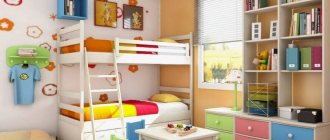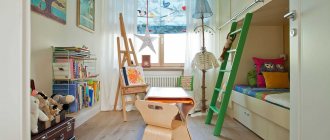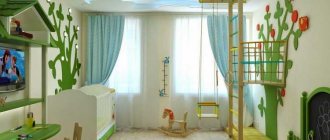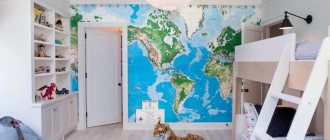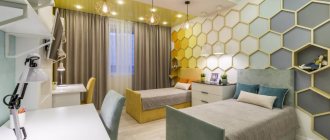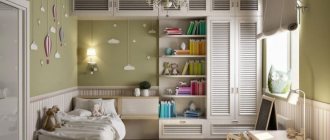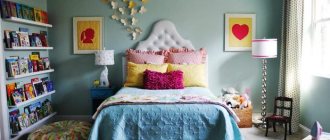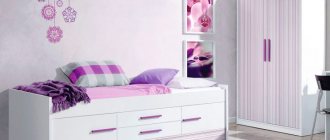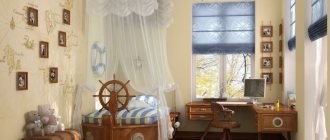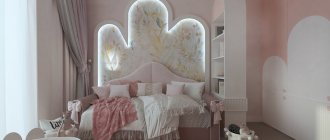Photo: uutvdome.ru Properly arranging a children's room is not easy, the task becomes even more complicated when we are talking about children of different sexes. After all, it is the parents who must foresee all the options in advance and make sure that the kids get along well in the same area. And so that everyone feels good and comfortable!
Territory in half
The main difficulty in designing a nursery for children of different sexes is not to offend anyone. Therefore, think about how to delimit the territory for two. Having your own space is especially important at a young age. After all, it is at this time that the perception of the outside world is formed and relationships with it are built.
Parallel zoning
An excellent scheme for spacious, and best of all, square rooms. Although you can think of an elongated room: you just need to experiment with the layout and location of windows and doors.
The room is simply divided in half. To do this, use a closet, rack, partition, curtains. The color scheme of both parts may differ. To prevent the nursery from looking too tacky, leave the general style, background or accents. For example, plain walls or beds of the same model, but with different colored textiles.
Diagonal zoning
Diagonal zoning differs from parallel zoning only in the location of the partition. This scheme is suitable for rooms with two windows on adjacent walls.
Diagonal division of the nursery is convenient to use in private houses or corner apartments.
Common areas
This division involves two separate sleeping places and common areas for games. This is convenient for small children of different sexes of about the same age. They happily play together, and cribs are enough for them to have privacy.
But when children grow up, problems may begin. You will need at least two separate workstations and two storage spaces.
Methods for zoning a children's room
Designers have long come up with many tricks for zoning rooms. You don't even have to “reinvent the wheel.”
Mobile partitions
Mobile partitions are the simplest tool for zoning. For example, folding screens. They can be removed during the day, and put back in at night or for classes.
Such partitions also differ from stationary structures in that they are visually lighter. This means they look less bulky in small rooms.
Plasterboard structures
From plasterboard you can create structures of any complexity and configuration: from lightweight interior walls to elegant semi-arches or low racks.
Plasterboard structures, unlike mobile partitions, cannot be folded or removed. But they have another advantage: you can build a whole storage system for things inside. And use the surface of low partitions instead of a table or shelf.
Cabinets and shelving
Now there are a lot of furniture options suitable for dividing a room. Of course, these are not bulky wardrobes in the ceiling. But racks with shelves for books and cute little things look lighter and immediately give the nursery a certain style and mood.
Pay attention to modular designs. Especially those that have access from two sides. They can easily replace a closet, chest of drawers or pencil case. And in modern interiors they can be played out in an interesting way with the help of decorative lighting.
Curtains
Thick curtains are usually built into the ceiling instead of a partition. More precisely, the cornice is mounted into a plasterboard structure. But this also has its advantages and disadvantages.
The advantage is that the curtains are easy to close and open as needed. They can always be removed for washing or replaced with new ones if children want to refresh the interior.
Disadvantage: textiles attract dust, get dirty easily and are a fire hazard. This is not the best option for small children. So first weigh the pros and cons.
Visual zoning
Visual techniques include zoning with materials, colors and textures. This also includes podiums and ceiling structures.
But in the case of dividing a children's room for children of different sexes, it is better to use such tricks as an addition, and not as a basis. Light and color alone can change the perception of a room, but not create two private corners.
But with the help of a podium and lighting, you can perfectly highlight a play or work area.
Finishing the ceiling of a wooden house from the inside
Finishing work to insulate the inner surface of the ceiling and give it an attractive appearance is a very important stage, since heat loss through the roof is no less than through the walls (all heat rises upward).
In addition, it is important to ensure that the roof is completely waterproof. If it is planned to equip a living room (attic) in the attic, accordingly, sufficient sound insulation and ceiling strength should be ensured
Most often, environmentally friendly wood materials are selected for these purposes. They create pleasant, clean air at home, and on their basis you can create a lot of design options for every taste.
Wood processing
The use of wooden cladding is the most natural and logical option in the case of interior decoration of a wooden house. The material options are as follows (in order of increasing service life):
- plywood;
- lining;
- massifs of coniferous species (spruce, pine, larch and others);
- more expensive solids (beech, bast, ash, birch).
Structurally, there are 2 technologies:
- You can leave the wooden load-bearing roof beams and use them as the basis of the design.
You can cover the beams with finishing material, as shown in the photo.
The finishing methods are very simple, and the ability to attach them to load-bearing beams allows you to complete all the work quite quickly. Some design options are presented in the video.
https://youtube.com/watch?v=RN4RYa_bmkw
other methods
Of course, along with wood materials, there are other technologies for manufacturing the inner surface of the ceiling in a wooden house. The most common option is to create a stretch ceiling.
Along with the obvious advantages in terms of the ability to create your own design and the high operational strength of the material, in the case of wooden houses there are significant disadvantages:
- suspended ceilings do not allow air to pass through, therefore, to some extent, a greenhouse effect is created;
- profiles from suspended ceilings together with the canvas may be slightly deformed as a result of the house settling.
Bed installation
The most difficult thing in a nursery for children of different sexes is to separate the sleeping places. For small rooms, bunk beds or modern transforming systems are suitable; they take up less space.
But if space allows, it is better to divide the sleeping areas more clearly, because the older the children get, the more they need their own corner.
In an elongated rectangular room, try placing beds against one wall and placing a mobile or sliding partition in the middle. Or build a curtain rod into the ceiling structure.
The easiest way is to install beds against opposite walls. And in the center of the room there will be a common area that the children themselves can share when they need it.
A convenient option is modern transformable furniture. In one such complex there will fit a bed, a table, and shelves with cabinets for storing things. Then in the rest of the room you can safely install a sports corner, a TV with a console or any other entertainment.
80 design ideas for a small children's room (photo)
Furniture selection
A spacious room for the nursery gives each boy the opportunity to have his own set of furniture, a personal comfortable corner for games and hobbies. But more often you have to deal with a lack of space, so functional solutions are needed. When choosing furniture for the nursery, adhere to the basic principles:
- strength, safety. Boys love to run, play active games and even fight. All furniture must be strong enough, avoid glass elements and sharp corners;
- environmental friendliness. A suitable material option for children's furniture is wood. If your budget is limited, choose furniture made from MDF;
- appropriate for children's sizes. A good option would be to choose furniture that “grows” with the child;
- To make cleaning a room easier, choose furniture with surfaces that are easy to clean.
Correct lighting
The right light is especially important for children's growing bodies. Moreover, kids are engaged in creativity, reading, studying, and doing homework. Therefore, you need to approach the organization of lighting no less carefully than choosing a bed or workplace.
Natural light
The best light is always natural. That is why the brightest room is traditionally chosen for children's rooms. Ideally, with windows facing east or southeast.
Sunlight affects the entire lifestyle of children, their emotional background, vigor and performance.
Even curtains for the nursery are recommended to be light, airy and transparent. And at night, if necessary, lower thick roller fabrics, like Roman blinds.
Artificial lighting
The current trend is multi-level lighting. This is especially valuable in a children's room.
— A bright overhead light is suitable for the play area. It is better to place the central chandelier above it. If this area is located in a corner, two-tier plasterboard ceilings with built-in spotlights will solve the problem.
— The middle level is shifted diffused light above the sofa, computer desk, or near the TV.
— The third level is working lighting. These are tabletops and swivel sconces above the desktop. It is important to think through this area so that children do not interfere with each other.
— Don't forget about the light above the bed. Choose soft, adjustable lamps for this. Especially when there are two children in the room. This way, one of them can, for example, read a book in bed without disturbing the other.
Power and brightness
Calculate the power of the lamps based on the following considerations: 10-15 Watts per square for the entire room, 50-60 Watts per square for the work and play areas.
Don't forget about color temperature. There are two types of light bulbs used for living rooms:
- At 3000-4000K. This is a warm yellowish light for chandeliers and wall lights in living rooms; - At 4000-5000K. This is a neutral background for functional rooms. It is used instead of daytime.
Lamps up to 3000K produce warm orange light. It's cozy for evening gatherings, but not suitable for everyday activities. Temperatures above 5000K are bluish white lamps, as in museums, hospitals, laboratories, and shops.
Decoration
Accessories that match the child’s character and lifestyle will help create a cozy and warm atmosphere.
Curtains that harmoniously match the overall color scheme of the interior will immediately transform the room. In this case, the presence of tulle is not necessary. It is enough that the curtains are thick and made of natural fabric.
To decorate the resting and sleeping area, you can choose a small rug with long pile. A lamp with an unusual design will look great on a bedside table.
If the walls are plain or have a small, discreet pattern, stickers, paintings, and photo collages are suitable for decoration.
The dressing table can be decorated with unusual lighting, beautiful boxes for storing hair clips, jewelry and other girlish little things.
The work and study areas will be decorated with books in beautiful covers and flowers in unusually shaped pots. The girl grows up and becomes a housewife, so she can learn to care for living plants.
When choosing accessories, you need to take into account the color scheme of the interior. The more neutral the background, the more decorations you can afford and vice versa. More ideas for decorating a girl's bedroom can be found here.
10 more design options
During such a difficult period, it is important to take into account the interests and preferences of your daughter. Otherwise you may lose her trust
Try to find a compromise in the design of the nursery. In the environment that the child himself chose, he will be much more comfortable than in the one that his parents chose against his will. Among the variety of designs and styles of children's rooms for girls, there is sure to be an option that both parties will like. And your daughter will be proud of such modern and understanding parents.
Inspire us - share the material with your friends on social networks:
Read with this article:
Color solutions
Each child is an individual with his own tastes and preferences. Naturally, children may like different colors and styles. Interests begin to form at the age of 3-5 years.
common topic
If a compromise has been reached between the children, the easiest way is to decorate the room in one color scheme. This will simplify the selection of furniture, textiles and parts.
Remember that children's preferences can change quickly. Therefore, for such global decisions, it is better to choose neutral themes that can be easily refreshed or changed with small details and accessories.
Simple modern interiors, natural, marine or space themes, laconic technological styles - be sure to consider these options.
Monochrome
You can visually divide a room even within the same color. For example, decorate one part of the room in darker and richer emerald shades, and the other in pastel light green or bleached khaki.
Natural textures and colors look very stylish in this interpretation: wood, sand, brown shades. And children will create accents for themselves with the help of their favorite toys, crafts and decorations.
Contrasts
To separate the room of children of different sexes, you can use completely different colors. But don't forget about color. And that the child’s psyche is sensitive to visual stimuli.
Choose different shades, but not too loud or harsh. For example, purple with gray, brown with green, yellow with blue.
How to choose wallpaper for a children's room: 85 photo ideas
Surface finishing
If the choice of color for decorating a room is done together with the children, then it is better to choose materials for the walls, ceiling or floor yourself.
The main requirement here is environmental friendliness and safety.
- The walls are covered with paper wallpaper or painted with water-based paint. Plastic, vinyl, and oil-based paint are not acceptable. Part of the wall for a boy or a girl can be made of cork (and framed in a frame of the same connecting shade that we have already talked about).
- The floor is wooden or cork. The latter is both soft and warm. It is advisable to make a noise-absorbing substrate, otherwise your neighbors below will not envy you.
- Stretch ceilings are beautiful, but no one can guarantee that a flying airplane or dart will not hit the canvas. You should not cover the ceiling with polystyrene foam boards - it will not breathe.
- Carpeting on the floor is acceptable, but with short pile, otherwise cleaning will be daily.
For windows, you need to choose curtains made from fabrics that attract the least dust. And give up gathers, ruffles, fringes and draperies.
Which style should you choose?
Decorating the interior of a room for children of different sexes is always more difficult. Therefore, the most popular design solutions are compromise ones.
Children's room in minimalist style
Minimalism itself is “bland” for a child’s room. But it will become a universal unifying background, on the basis of which you can design different zones with the help of accents. This way, even a bright nursery will not be tacky.
Children's room in high-tech style
Technological high-tech is, first of all, lightness and functionality. For example, a frame metal shelving unit for zoning a room is much lighter than a classic closed bookshelf.
Any sports and gaming corners easily fit into the hi-tech.
Children's room in loft style
Loft interiors are ideal for creative children. They are deliberately rough, simple and eclectic. This means they create an ideal basis for self-expression.
Children's room in Scandinavian style
Scandinavian style is warmer and more comfortable than conventional minimalism. He gravitates towards natural materials and colors. And also - to hand-made, so that children can decorate the room with their own crafts.
Children's room in classic style
The classic desire for symmetry is an excellent basis for zoning and arrangement of furniture. Massive furniture is functional and roomy. Natural wood, stone and textiles are environmentally friendly and safe.
Classic interiors are suitable for older children.
Small nursery for children of different sexes
Planning a comfortable nursery for children of different sexes in a small room is very difficult. After all, you can’t just give up toys, textbooks and other important little things.
If possible, move the closet outside the room. Leave only the most necessary areas in it: sleeping, working, playing. In the same way, it is better to take out the sports corner or musical instruments.
If the nursery has access to a balcony, feel free to insulate it and take down the partition. You can remove it completely and expand the space, or you can leave it in half and arrange its surface as a work area.
Decorating a room for a teenager: 85 design solutions
Accessories
To diversify the design of a children's room intended for children of different sexes, it is important to choose the right accessories; they will give the decoration a complete and cozy look, emphasizing the individuality of each child. Boys will certainly be interested in the sports corner, especially if they go to sports sections.
The girl will probably ask for a dressing table with a large mirror and drawers where she will put jewelry and cosmetics. Children 3-4 years old will enjoy interesting colorful playhouses decorated in their favorite colors. Options for decorative design of a children's room, intended for two children of different sexes, on an area of 12 square meters. m for reference are presented in the selection of photos below.
Important! Let there be free space on the walls - teenagers love to cover them with posters of their favorite actors, musicians or athletes.
Nursery design for children of different sexes - photo
To finally decide on a suitable solution for such an important task, first study different examples and projects. To do this, we have prepared a selection of photographs of existing interiors of rooms for children of different sexes. Watch and get inspired!
